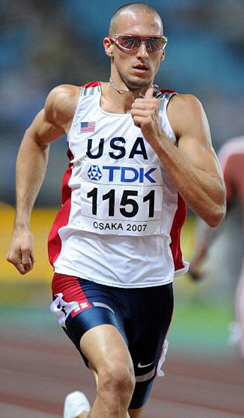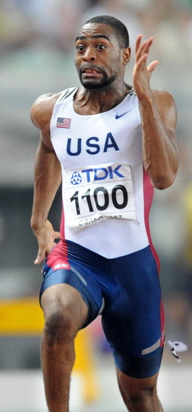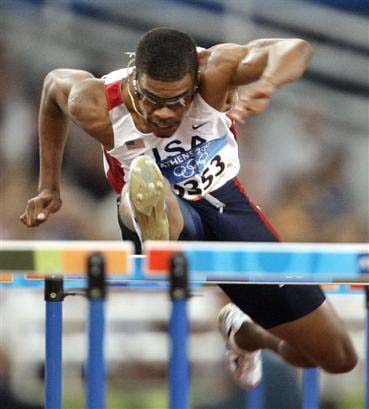In watching the most recent world championships, it caught my eye that Angelo Taylor, well-known as the 2000 Olympic champion in the 400 hurdles, finished 3rd in the open quarter. Also, Taylor ran a leg on the US gold medal winning 4×400 relay. When you add in the fact that Kerron Clement, WC gold medalist in this year’s 400 hurdles, also has run a 44-mid open quarter in his career, and both of them have only decent hurdling technique, it makes you wonder: is the 400 hurdles a hurdler’s race or a quarter-miler’s race?
Some observations:
You don’t get too many 110 hurdlers running the open 100, but you do get a lot of 400 hurdlers running the open quarter.
The “art of hurdling” – the ability to negotiate very tall barriers as they’re rushing up at you – refers more to the 110 meter high hurdles. The 110s will almost always be won by the better hurdler, not the better sprinter, because the better sprinter doesn’t have room to sprint.
In the 110s there’s 51 strides, only ten of which are over hurdles. In the 400h, there’s somewhere in the neighborhood of 150 strides, only ten of which are over hurdles. So, in the 400h, there is a lot more room to recover from mistakes, and a lot more room to cover ground and take advantage of one’s stride length between each hurdle, and off the final hurdle.
Technical efficiency reduces fatigue, as does developing a consistent stride pattern. So hurdling skills certainly matter n the 400h. A Jeremy Wariner or LaShawn Merritt couldn’t just “jump” over hurdles and be competitive with a Batman, Carter, Clement, or Sanchez. But, with training, a Wariner would have a much better chance of becoming a world-class 400 hurdler than a Tyson Gay would of becoming a world class 110 hurdler.




Could Wariner beat Taylor in the 400H? Probably not. But with training he’d have a better chance than Gay would of beating Trammell in the 110s.
Great high school hurdlers who do both but have many technical issues generally gravitate toward the 400 hurdles in college. Rickey Harris and Kerron Clement are both examples. Harris ran something like a 13.57 over the 39s in high school and beat future two-time NCAA champion Josh Walker at the National High School Championships in doing so, but Harris didn’t run the 110s in college. When he beat Walker in high school, Walker was obviously the better technician, but that didn’t matter as much over the 39s.
400 hurdlers are better off devoting practice time to strength development (over-distance) and speed development (under-distance) than to perfecting technique. If it’s a cut-your-losses situation, the running matters more than the hurdling in regards to dropping time.
Technique becomes more important when striving for consistency. Edwin Moses is the most obvious example. He took 19 strides to the first hurdle, 13 between all the rest, with excellent hurdling mechanics. He could run 48-low and in the 47s on a regular basis.
To me, rhythm between the hurdles (stride pattern) is an aspect of technique. Hurdlers have to have rhythm. Sprinters can just run.
Clement isn’t consistent with his stride pattern, and his technique is suspect, so he’s a hit-or-miss hurdler. He might bust a monster race on occasion, but he also is prone to making race-killing mistakes. But his quarter-mile speed will always put him in contention coming into the final straightaway. Same with Jackson. The lack of a consistent stride pattern has cost him twice now (at the ’04 Olympic trials and the ’07 WC semi-final), but he won the ’05 WCs with a 47.30 in the pouring rain. Those guys will never be on the level comparable to that of Moses, or of Sanchez from earlier in this decade, until they can develop more consistency with their stride pattern, which also means they will have to be more technically proficient on top of the hurdles, since hurdle clearance directly affects the ability to maintain stride pattern.
Final Thoughts:
Hurdling technique matters in the 400 hurdles, but with all things being equal technically, the better quarter-miler will win. There’s enough space between the hurdles for the better quarter-miler to recover from mistakes and gain ground. Especially in the run-in (35 meters) off the last hurdle. But the opposite is also true. With all things being equal regarding quarter-mile speed, the better hurdler will win, because technical mistakes become magnified. Of course, the best 400 hurdlers have both. In the 110s, 100-meter speed doesn’t necessarily translate into fast 110 hurdle times. But in the 400h, quarter-mile speed does translate much more accurately.
© 2007 Steve McGill
